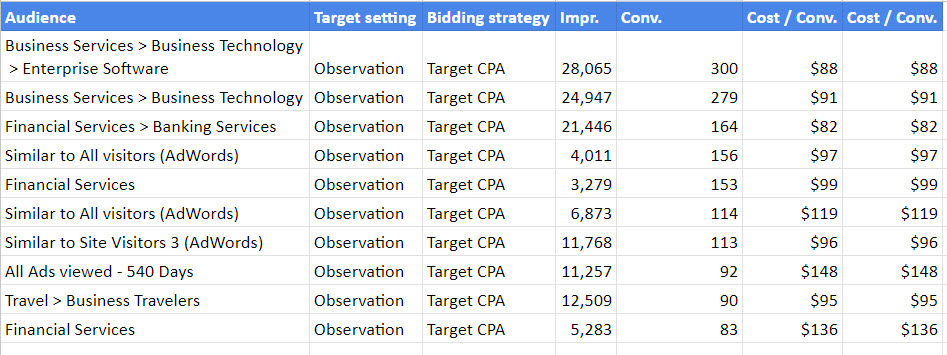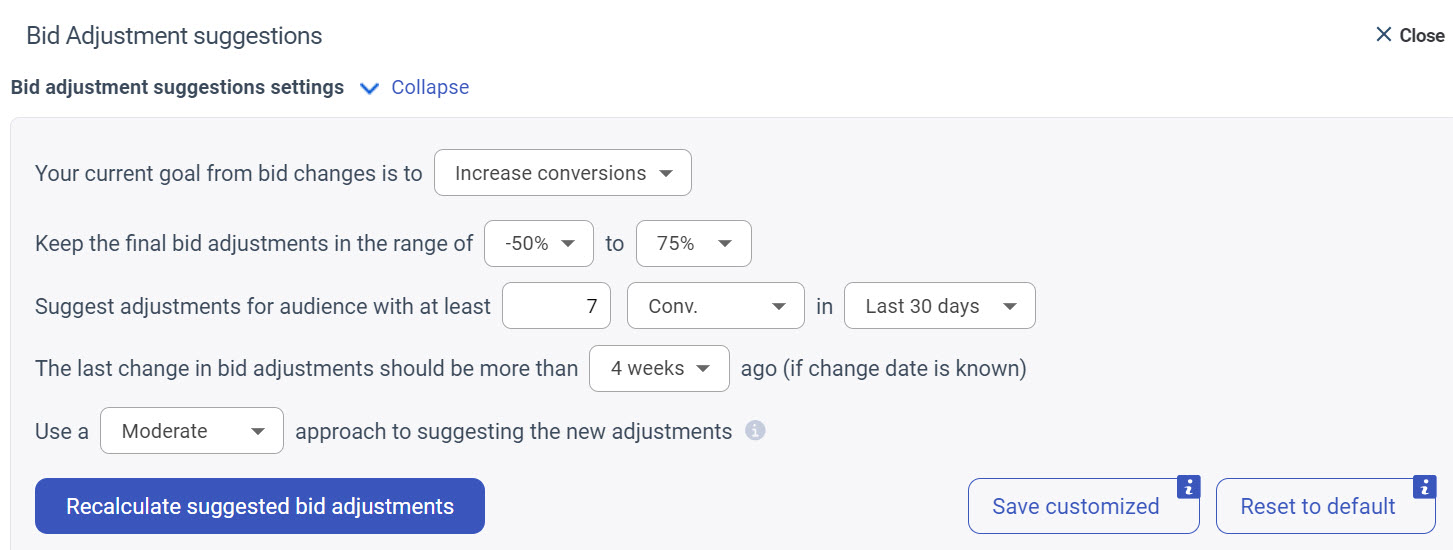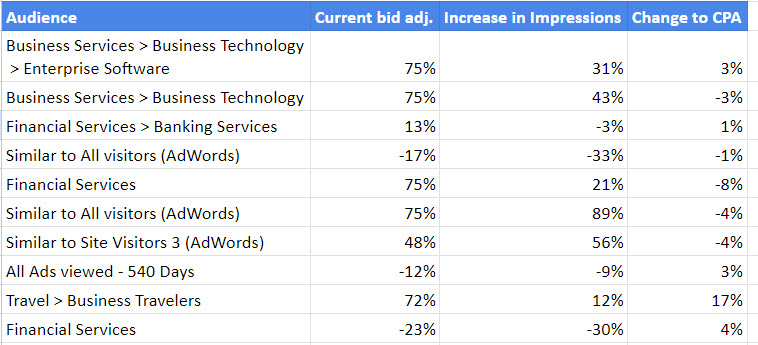Most of the time, accounts that are using smart bidding (i.e. automated bidding) ignore bid adjustment since most of them do not work with automated bidding.
If you are using “max” bidding, then you can’t use bid adjustments (with the exception of max clicks, which we are not discussing today). If you are using “target” bidding, as in Target CPA or Target ROAS, then you have two bid adjustments available to use: Device and Audiences. (Bid adjustment map here).
Device adjustments work exactly as expected; the target ROAS or CPA is adjusted by the modifier’s amount. For instance, if you have a $50 CPA bid and you have a -50% mobile device adjustment, then your target CPA is $25 on mobile devices.
Audience adjustments work completely differently than any other adjustment when combined with Target CPA or Target ROAS bidding. Audience adjustments affect the ‘priority’. That’s a pretty ambiguous statement by Google. What this actually means is that if you have a positive bid audience bid adjustment, then Google will try to serve your ad more often to that audience. Conversely, if you have a negative adjustment, then your ad should be served less to a group.
To test how well this works, we took an account that uses Target CPA bidding and has hundreds of audiences in it. Here’s a small sample of some of the audiences.

Starting with this data, we used the Adalysis Bid Adjustment Calculator to determine what the adjustments should be as if we were using the audience adjustment in a manual CPC campaign and applied those numbers to Target CPA campaings.

The goal was to see how adding an adjustment would change the data. How many more impressions would we get since our ad had a different priority? We also wanted to see how much the CPA would change with positive and negative adjustments.
There are a few things to consider when thinking about how to read this data.
Impression Share: We can’t get audience level impression share data, so we don’t know how many impressions we’re missing. If we had an 80% impression share for an audience and we added a 200% bid adjustment, we can’t actually triple our impressions – they don’t exist.
Unique Users: A searcher can be in multiple audiences at the same time. However, Google only shows stats in your account for that user once, so if someone is in 3 audiences Google doesn’t add the data to all three audiences; they just choose one audience for that user. Therefore, it is possible to have an audience with a positive adjustment decline because the stats were associated with a different audience (presumably one with an even higher bid adjustment)
CPA Changes: Since audience adjustments should only affect priority levels, we wanted to look at CPA changes to see how they would change. We didn’t expect them to be the exact same since data changes so much month over month.
Impression Changes: How closely aligned would the impression changes be with the adjustment? Knowing that we can’t get impression share data and users can be in multiple audiences, we were looking for correlation over exact numbers.
Here are the results of the test:

We can see that the first two bid adjustments, which are +75% had a substantial increase in impressions, however, they were lower than the bid adjustment. We did have one audience that was more general (Similiar to All visitors) that had an increase in impression greater than its modifier. We also had one audience (Banking Services) with a positive adjustment that had a small decrease in impressions.
Adding a positive audience bid adjustment should increase your impressions for that audience. However, based on impression share and how Google reports audience numbers, the change is more directional than absolute.
We were also happy to see that adding a negative audience lowered impressions for those audiences. The numbers were again directional as two audiences had larger decreases in impressions than the negative bid adjustment. That could be attributed to Google just showing us less since we asked to be shown less to those users, or those users could have just switched from one audience to another one.
Overall, the CPAs didn’t change much. Across all of the audiences (not displayed) that had at least 80 conversions in the past 30 days, none of the CPA changes were above or below 20%. The vast majority were +/- 10%, with most being within 5% of the previous CPA.
If you are using Target CPA or Target ROAS (which perform much differently than max conversions or revenue), then don’t forget to use audience bid adjustment in your optimization efforts. The adjustments are directional and will not correspond directly to changes in impressions or conversions. However, it’s very easy to set your bid adjustments, so don’t forget to pull that lever.
If you’re looking to automate the bid adjustment process, you can take a 2 week free trial of Adalysis, as that’s just one of many optimization features that you’ll find in the software that will make your life easier and your account’s more profitable.
Odd, Google help docs continue to say audience adjustments don’t work.
“Bid adjustments and Target ROAS
Bid adjustments allow you to show your ads more or less frequently based on where, when, and how people search. Because Target ROAS helps optimize your bids based on real-time data, your existing bid adjustments aren’t used. There is one exception: You can still set device bid adjustments of -100%.”
Isn’t smart bidding like tROAS and tCPA supposed to be “smart enough” to read, for example, that mobile devices covert more efficiency and then automatically bid more there to meet our roas targets? to me, the device is just like the time of day, term, or even day of the week… even location! It just doesn’t make sense to me why I would want or need to tell google to bid higher for a specific device type (or audience) if that is just another signal the smart bidding algorithm should consider.